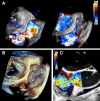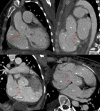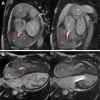A multimodality approach to a rare case of ruptured sinus of Valsalva aneurysm with tricuspid valve involvement: a case report
- PMID: 37743896
- PMCID: PMC10516659
- DOI: 10.1093/ehjcr/ytad454
A multimodality approach to a rare case of ruptured sinus of Valsalva aneurysm with tricuspid valve involvement: a case report
Abstract
Background: Ruptured sinus of Valsalva aneurysm is a rare disease entity that is potentially life-threatening if left untreated. While imaging is the mainstay of diagnosis, resultant tricuspid valve involvement may mask typical findings providing a diagnostic challenge. Disruption of the tricuspid valve during ruptured sinus of Valsalva aneurysm with consequent tricuspid regurgitation is rare and infrequently described in the literature. Description of the utility and limitations of multimodality imaging in this scenario is equally scarce.
Case summary: We review the case of a young patient presenting with acute ruptured sinus of Valsalva aneurysm and involvement of the tricuspid valve on a background of severe aortic regurgitation requiring multimodality imaging for diagnostic and pre-surgical assessment.
Discussion: In young patients presenting with acute decompensation and pre-existing bicuspid aortic valve regurgitation, an increased clinical suspicion of a sinus of Valsalva aneurysm rupture is imperative. Doppler and 3D transoesophageal echocardiographic assessment should be pursued to characterize abnormal flows and clarify aetiology in the context of tricuspid involvement and resultant tricuspid regurgitation. A large-volume left-right shunt in proximity to the tricuspid annulus may result in disproportionately severe tricuspid regurgitation in the absence of annular disruption due to forced systolic opening of the leaflets by shunt flow and 'windsock' prolapse. Multimodality imaging can be essential in these cases to adequately assess the extent of the ruptured sinus of Valsalva aneurysm and overcome limitations of single modality imaging.
Keywords: Case report; Congenital heart defect; Echocardiography; Multimodality imaging; Tricuspid valve.
© The Author(s) 2023. Published by Oxford University Press on behalf of the European Society of Cardiology.
Conflict of interest statement
Conflict of interest: None declared.
Figures





References
-
- Bricker AO, Avutu B, Mohammed TL, Williamson EE, Syed IS, Julsrud PR, et al. . Valsalva sinus aneurysms: findings at CT and MR imaging. Radiographics 2010;30:99–110. - PubMed
-
- Kuroda M, Takahashi K, Matsumoto S, Oshima M. Impact of intraoperative transesophageal echocardiography for noncoronary sinus of Valsalva aneurysm with severe tricuspid regurgitation. J Cardiothorac Vasc Anesth 2020;34:2169–2173. - PubMed
-
- Plambeck C, Eiseman M, Iqbal Z, Pagel P. A small circular structure in the right atrium: a cause for right atrial and ventricular dilatation? J Cardiothorac Vasc Anesth 2013;27:628–630. - PubMed
Publication types
LinkOut - more resources
Full Text Sources
